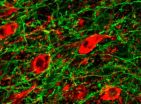New models predict patterns of brain damage in dementia
2012-03-22
(Press-News.org) Two breakthrough studies may explain why we see distinct patterns of brain damage associated with dementias, such as Alzheimer's disease, and could be useful for predicting future cognitive decline in patients. These independent studies published by Cell Press in the March 22 issue of the journal Neuron, one studying how brain circuits wire up structurally and the other studying their functional connections, converged on a remarkably similar model that predicted the landscape of degeneration in various forms of dementia. This is particularly significant because, until now, models for predicting regional neurodegeneration in humans have remained elusive.
Different dementias involve distinct parts of the brain, and previous research has led to the theory that neurodegenerative diseases target specific networks of neurons that are linked by connectivity rather than spatial proximity. Further, this neurodegenerative process is thought to involve the accumulation of abnormal toxic proteins and possibly even the spread of these proteins between neurons, which my travel from neuron to neuron through their synaptic connections.
One study, led by Drs. Juan Zhou and William Seeley, from the University of California, San Francisco, addressed this theory. "We were interested in whether knowing the healthy brain's functional "wiring diagram" would help us predict specific patterns of neurodegeneration seen in patients," explains Dr. Seeley. "For each illness we studied, specific regions emerged as critical network 'epicenters,' and functional connectivity to these epicenters predicted each region's vulnerability. The findings best fit a model wherein disease spreads from neuron to neuron along network connections that link brain structures."
In a separate study, led by Dr. Ashish Raj from Weill Medical College of Cornell University, researchers modeled this same kind of "transneuronal" disease transmission by mathematically analyzing structural connectivity networks obtained from healthy brain MRIs. Their model predicted spatially distinct "eigenmodes," tightly connected subnetworks in the brain, which mirrored classic patterns of damage seen in dementia.
"Our findings provide the first plausible explanation of why various dementias appear to selectively target distinct regions of the brain—as a simple mechanical consequence of transneuronal spread within the brain networks. This also suggests that all dementias, previously considered to be pathologically distinct, might share a common progression mechanism," concludes Dr. Raj. "Importantly, this model of disease progression may be useful clinically for prediction of future cognitive decline in patients, based on their current MRI scans. Knowledge of what the future holds would allow patients to make informed choices regarding their lifestyle and therapeutic interventions."
INFORMATION: END
ELSE PRESS RELEASES FROM THIS DATE:
2012-03-22
CHAPEL HILL, N.C. – What characterizes many people with depression, schizophrenia and some other mental illnesses is anhedonia: an inability to gain pleasure from normally pleasurable experiences.
Exactly why this happens is unclear. But new research led by neuroscientists at the University of North Carolina at Chapel Hill School of Medicine may have literally shined a light on the answer, one that could lead to the discovery of new mental health therapies. A report of the study appears March 22 in the journal Neuron.
The study used a combination of genetic engineering ...
2012-03-22
In a medical malpractice case, an Ontario appeals court recently affirmed a lower court's award of $8.5 million to the family of a severely brain-damaged woman. Born with cerebral palsy, the woman nearly died at birth due to a nurse's failure to properly monitor her heartbeat during labor. Lawyers for the family said that the nurse didn't measure her heartbeat often enough to detect oxygen deprivation over a period of one to three hours.
The woman, now grown, lives in an assisted care facility and depends on her family for care and financial support. Family members said ...
2012-03-22
STANFORD, Calif. — Investigators at the Stanford University School of Medicine have shown that removing a matched set of molecules that typically help to regulate the brain's capacity for forming and eliminating connections between nerve cells could substantially aid recovery from stroke even days after the event. In experiments with mice, the scientists demonstrated that when these molecules are not present, the mice's ability to recover from induced strokes improved significantly.
Importantly, these beneficial effects grew over the course of a full week post-stroke, ...
2012-03-22
VIDEO:
George Cotsarelis, MD, explains that an abnormal amount a protein called Prostaglandin D2 inhibits hair growth in the bald scalp of men, a discovery that may lead directly to new...
Click here for more information.
PHILADELPHIA - Researchers from the Perelman School of Medicine at the University of Pennsylvania have identified an abnormal amount a protein called Prostaglandin D2 in the bald scalp of men with male pattern baldness, a discovery that may lead directly to new ...
2012-03-22
Public scrutiny and the threat of government regulation are leading to a decline in industry-sponsored funding of accredited continuing medical education (CME) for physicians, and this decline represents an opportunity to make CME more relevant, cost-effective and less open to bias, wrote a group of physicians from the San Francisco VA Medical Center and the University of California, San Francisco.
In a "Perspective" in the March 22 issue of the New England Journal of Medicine, the authors predicted the decline will continue, with a "sea change toward greater restriction" ...
2012-03-22
When it next meets, the governing board of the National Basketball Association will consider allowing corporate advertising on players' official game jerseys. According to the Sporting News, the NBA is the last major American sport to have no logos other than the team name on its official game uniforms -- Adidas currently has logos only on NBA warm-ups.
Sports such as soccer, NASCAR and even the Women's National Basketball Association have no qualms about giving corporate sponsors prominent placement on vehicles, equipment and jerseys. For example, in 2009 the WNBA's ...
2012-03-22
SAN DIEGO (Embargoed until 2 pm (ET), March 21, 2012) – New findings from a landmark research study led by Scripps Translational Science Institute (STSI) – a collaborative program between Scripps Health and The Scripps Research Institute (TSRI) – shows a promising new blood test may be useful in helping doctors predict who is at risk for an imminent heart attack.
Results of the study titled, "Characterization of Circulating Endothelial Cells in Acute Myocardial Infarction," were published this week in Science Translational Medicine. The study concludes that circulating ...
2012-03-22
The physical phenomenon of plasmon resonances in small metal particles has been used for centuries. They are visible in the vibrant hues of the great stained-glass windows of the world. More recently, plasmon resonances have been used by engineers to develop new, light-activated cancer treatments and to enhance light absorption in photovoltaics and photocatalysis.
"The stained-glass windows of Notre Dame Cathedral and Stanford Chapel derive their color from metal nanoparticles embedded in the glass. When the windows are illuminated, the nanoparticles scatter specific ...
2012-03-22
ESO's VISTA telescope has been trained on the same patch of sky repeatedly to slowly accumulate the very dim light of the most distant galaxies. In total more than six thousand separate exposures with a total effective exposure time of 55 hours, taken through five different coloured filters, have been combined to create this picture. This image from the UltraVISTA survey is the deepest [1] infrared view of the sky of its size ever taken.
The VISTA telescope at ESO's Paranal Observatory in Chile is the world's largest survey telescope and the most powerful infrared survey ...
2012-03-22
Workplace safety is a major problem in the United States. Every year, approximately 6,000 workers are killed, and millions more are injured, in on-the-job accidents.
Safety is everyone's responsibility. Management, however, often tries to place the burden on workers alone. A new study from the University of Georgia shows that this emphasis might be misplaced. It found that high-level decisions about workplace safety and work-life balance can greatly reduce workplace accident rates.
The study examined employees' perceptions of workplace climates across a wide variety ...
LAST 30 PRESS RELEASES:
[Press-News.org] New models predict patterns of brain damage in dementia


